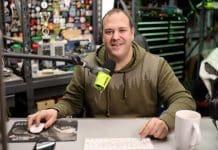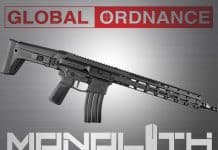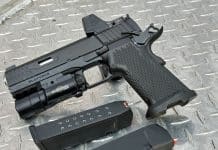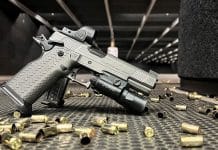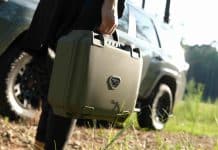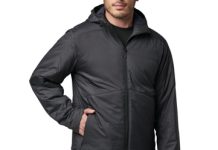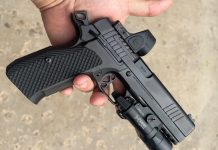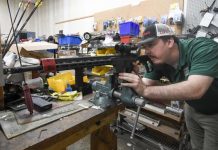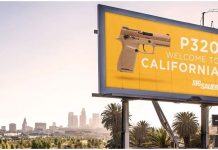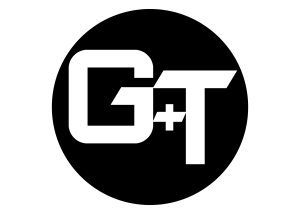
DISCLAIMER: A PISTOL MOUNTED RED DOT AND COMPENSATOR WILL NOT TURN YOU INTO JERRY MICULEK.
It is clear that compensators are well on their way to reaching the same status as pistol mounted red dots. Red dots on pistols started moving into the law enforcement/ military/ tactical world a few years back and was popularized greatly by Trijicon with their RMR. Many flocked to the RMR and joined in the bandwagon because of how badass it made their gat looked, and with that many quit shortly after because of the immense learning curve there is to become proficient with shooting a red dot mounted onto the slide of a pistol. The added weight of the RMR causes the muzzle to rise slightly more bringing the red dot out of the window causing you to start bobbing your head like a duck just to find the dot again. “Screw this I’m faster with irons.”
Enter the compensator.
Compensators on pistols are nothing new. Competition shooters have been using them for years, and lately they have been gaining popularity in the civilian market thanks to social media platforms such as Instagram and Youtube and also in part to the growing popularity of the “Roland Special,” a highly modified combat-oriented Glock. I am not going to go into the details of its origin as there is plenty of information out there and I’d rather not butcher the details. Like pistol mounted red dots, it is starting to reach normalcy in the carry world. To learn more, I reached out to Scott “Jedi” Jedlinski of the Modern Samurai Project to get some insight on the use of compensators.
I’m not gonna lie, the first time I saw the Roland Special I thought it was butt ass ugly. But after shooting my friend’s take on the build, I fell in love. Now don’t get me wrong, 9mm is already a pretty lightly recoiling caliber. But the compensator combined with the RMR and surefire x300 made for a soft shooting, fast tracking gun. The dot on the pistol stayed in the window and all I had to do was make sure that dot stayed on target and I was on.
What it do?
So what exactly is the purpose of the compensator? Most people assume that its primary purpose is just to reduce recoil and keep the muzzle flat just like they do on AR-15’s so that you can shoot faster. After speaking with Scott, he shed some light on some of the assumptions I had on compensators by explaining the philosophy of use behind the Roland Special. “It’s a package deal” said Scott. “It is the combination of the light, the compensator, the red dot, the mag well and correctly tuned recoil and striker springs that make the Roland ‘special’.” All those work in conjunction to make the weapon what it is. The added weight of the comp and the light, in addition to the compensator working to keep the muzzle and slide to track flat that keeps the red dot in the window to be able to remain on target and allow for faster follow up shots. Shooting fast especially on the move in a tactical environment is what the Roland provides.
One does not NEED a red dot or a compensator on their pistol to shoot faster or more accurate. All you need is a reliable working gun, some ammo, training from reputable instructors, time and repetitions, as it will not happen overnight. I say reputable because there are plenty of youtube/Instafamous shooters that claim to be high speed instructors so watch out. Compensators (and red dots) will not put a band aid on your bad fundamentals so don’t purchase one thinking that will happen. What it will give you is a huge serving of humble soup as it will expose your bad habits ten-fold. For those who train constantly and have a good grasp on their fundamentals, this may enhance or even take your skills to the next level with ample training.
A common argument to compensators on a pistol is “but 9mm is such a light recoiling caliber and you’d be a sissy man if you need a compensator for 9mm.” This kind of response is usually born out of ignorance and assumptions from people that have little to no experience shooting compensated pistols. “It is not the recoil, it is the flatness.” says Scott. Recoil is inevitable in regards to shooting thanks to the height over bore issue with most modern pistols. Time and proper training with recoil management are the only things that will help you to better mitigate recoil. The purpose of the compensator is not necessarily to decrease the recoil, but to keep the muzzle flat in order to be able to track front sight or red dot faster for faster follow up shots.
“If you could shoot a .22LR and make the same size hole as a 9mm, .40s&w or .45 acp, would you?” says Scott.
I go, “Duh why not!”
“Exactly, and that is the point!” says Scott.
The hotter the ammo the better. One would think that hotter ammo would mean more recoil, more recoil equals more flip so why bother. But in fact hotter ammo means more gasses pushing down and to the sides of the pistol to keep the muzzle even flatter.
Close Retention Shooting
How about close retention shooting? Internet experts say that you could lose an eye or burn your face because of the hot gasses coming out of a compensator. According to Scott, the issue of being blasted in the face with hot gasses or even the chance of spall or a jacket breaking off out of the port and into your face is a non-issue. Spall coming out would most likely be caused by some pretty crappy ammo, and if you are using quality, properly jacketed self-defense ammo you should be ok. Hot gasses? If you are being mugged or assaulted, getting into a small scuffle, and are already that close to make a retention or contact shot, hot gasses to your face will be the least of your problems.
Low Light/No Light Shooting
Will the blast from the ports temporarily blind you? Scott says “No, absolutely not, that is absurd. Even under night vision, running muzzle brakes on AR15’s and the Roland special, the temporary flash will not disorient you. Especially in high stress events when the adrenaline is pumping, the blast produced by the comp is not a factor.” This leads into shooting indoors without ear protection especially in a home defense situation. There is a phenomenon called auditory exclusion, often seen in soldiers and police officers, in which high stress events cause temporary hearing loss. “If you have ever been in a fight, or watch MMA, you will see coaches yelling at their fighters, but they are not hearing anything because all they can hear is their heartbeat. They are focused on the fight, just like tunnel vision,” said Scott.
So let’s talk about pro’s and con’s.
Pro’s
Flat tracking slide
Faster follow up shots
You look cooler
Shoot more and train (because who doesn’t like shooting and training)
May enhance shooting ability for those with proper fundamentals
Con’s
Initial Cost (especially if you are building a Roland Special)
Time to train
Cost for Ammo to train
Need new holsters
Comfort carrying concealed (subjective to shooter)
Options
The great thing about today’s gun industry is that you have options. More and more companies are churning out their own version of compensators specifically marketed for the everyday carry/concealed carry crowd. When it comes to size, most compensators will bring a Glock 19 to about the length of a Glock 34. Companies like Primary Machine with the Stealth Comp, Texas Black Rifle Co. with the Micro Comp for Glock and M&P, and the just-released Weapons Armament Research with the Lock on Compensator or WAR-LOC that does not require a threaded barrel like other comps (Cali shooters rejoice!). Whats even more exciting is that there are much smaller compensators coming out now that bring a Glock 19 to the length of a Glock 17 like that seen on the Agency Arms NOC. S3F Solutions and Mayhem Syndicate have collaborated to bring one such comp to the market and one from Blacklist is coming out soon too. So if the added size is bothering you, make sure to check out Mayhem Syndicate and Blacklist. Now the Glock 34 is not meant for concealed carry, but it surprisingly conceals very well since the grip does not change. Comfort is obviously subjective as everyone is built differently. I’ve had no issues carrying my version of the Roland rocking an Inforce APL instead of a Surefire X300U.
Verdict
So with all the benefits of having a compensator on your pistol, it is hard to argue why one with sound fundamentals and experience would not carry with one. If competitive shooters are using them to be faster, and operators are using it to be more lethal, then why shouldn’t we use it to better protect ourselves? There are plenty of compensators out there already with more coming out to the market so you will have plenty of choices, and most come in just under $100. Do you need it? Absolutely not. But you are going to get one anyway, so you may as well sit down and take the time to learn what it’s all about and go take some classes.
Now just like with red dots, there will be those that will buy a comp just to look cool but not take the time to properly train with it and some will eventually even abandon the idea. Like I stated earlier, these accessories are not to be used as a crutch in order to fill a void in your skill levels. Time and training are always paramount. Forego these and you just look like a jackass.
Check out more from our blog.
Want more posts like this one? Subscribe to Guns & Tactics to receive email updates and special offers direct to your inbox!
Social Links:
– The views and opinions expressed on this web site are solely those of the original authors and contributors. These views and opinions do not necessarily represent those of Guns & Tactics, the administrative staff, and/or any/all contributors to this site.
– Affiliate Disclaimer: Guns and Tactics is reader/viewer supported. This post may contain affiliate links and we may earn a small commission when you click on the links at no additional cost to you. As an Amazon Affiliate I earn from qualifying purchases.


